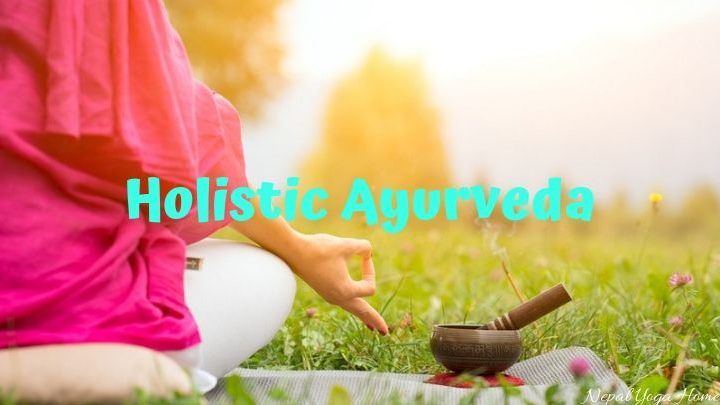
by Nepal Yoga Home | Sep 10, 2019 | Yoga
Overview Holistic Ayurveda
“Ayurveda treats the whole person, not just the organ or system involved.”
Dr. Vasant Lad, Textbook of Ayurveda
What is Ayurveda?
World over Ayurveda is known as the science of life, knowledge about life and longevity. If we go a little deeper Ayurveda is the methodology to establish harmony among the body, mind, soul and the environment. This ensures that Ayurveda is a holistic science with a colossal relationship with nature. Our aim as Ayurvedic healer is just to maintain this harmonious relationship through different means. Thus Ayurveda may be associated with various aspects in human life, how to lead a healthy long-life free from disease and infirmity. How the life span of a person may be increased through Kayakalp? What we are doing to maintain this balance? How to keep our relations intact with Mother Nature without disturbing the balance, while we fulfil our all requirement from her? One possible reply of all questions is “Sustainable use of Bio-diversity and replenish them properly.”
Health From Holistic Ayurvedic Stand Point
(Samdoshah Samagnishcha Samdhatumalakriyah Prasannatmendriyamanah Swasth Ityabhidhiyate.)
Shushrut Samhita 5/48 According to Sushrut Samhita (Beyond 1000B.C.) a healthy person is ‘One whose metabolism is good (Samdosha samagnish) whose tissues are functioning normally (Normal seven body elements), whose elimination is in balance and who is pacified at subtle, sensory and mental level’.
The first part is fulfilled perfectly through Ayurveda and the second part through Yoga (Holistic Approach). Thus Ayurveda and Yoga are sister sciences and they are complementary to each other.
The human body is composed of five basic elements like cosmos. These are further transformed in Tridoshas. Ayurvedic therapy is a perfect model to maintain the health of a healthy person and eradicate the disease and disharmony of ‘Doshas’ in an imbalanced state. Charak Samhita Su. 30/26. Ayurveda and Yoga are sister sciences, they are a supplement to each other to bring a harmony of body, mind and soul. It is difficult to detect such a cross-cultural bridge between Health, Society, Environment and wisdom of the ancient sages who dwelled in the forest and created a beautiful world of harmony between human and nature.
Routine is one of the most important aspects of this holistic medicine. You have probably experienced it yourself when you have a good routine, life seems to flow and there somehow is more time in the day. Ayurvedic Daily Routines (you can think of them like your grandma’s wisdom) will start making you and your loved ones feel better immediately.
We All Originated From The Five Basic Elements:
- Air, Space = Vata – V
- Fire, Water = Pitta – P
- Water, Earth = Kapha – K
Our body is a big pharmacy; manufactures many chemicals of her need daily. But we are adding a lot of unnecessary chemicals from outside while we have the natural option of many of them.
We Are Consuming These Unwanted Chemicals in Various Forms:
- Fertilizers, Insecticide and pesticides as residue in our foods.
- The synthetic chemical in our medicine, Health foods and cosmetics.
- Inhaling petrol and diesel fumes.
- Many pollutants found in our environment which are not biodegradable.
These chemicals & pollutants are representative of FIRE. They are increasing FIRE element in our body, which is represented by PITTA, resulting in anger, lust, greed, jealousy and war.
Conclusion
Realize, we are a member of a family we have to live together peacefully. Adopt a natural lifestyle, herbal things preparations; avoid harmful synthetics for the sustainability of this planet, which is only one of its types till now. Adopt a holistic Ayurveda approach.

by Nepal Yoga Home | Sep 9, 2019 | Yoga
Overview Ayurvedic Treatment For Female Infertility
Infertility is “a disease of the reproductive system (Artav vaha Srotas) defined as a failure to achieve conception after 12 months or more having regular unprotected sexual intercourse.” The female factor is directly responsible in 40-55% among which Prevalence of infertility due to ovarian factor is 15-25 %, tubal factor causes 25-35%, uterine factor 10 % and cervical factor 5%.
In Ayurveda essential factors for healthy Conception are Ritu(Favourable Time viz. Ovulation Period), Kshetra(Site of fertilization), Ambu(Presence of Nutrition), Beeja(Male and female gametes); any vitiation in these factors lead to infertility. Hrdi Samyata, Anil samyata are also considered as essential factors. Here Anil Samyata is mainly considered as the normalcy of Apana vayu. Pitta ,kapha and other structures are lame without the action of Vata.
So, Vayu is considered as prime dosha among Tridosha, by controlling Vata, Kapha and Pitta ultimately come in its equilibrium stage Basti therapy (Medicated enema therapy) are propounded as the best line of treatment for vitiated Vata, Uttar Basti is described as chief procedure among Panchkarma to rectify Ovum related disorders. Hence keeping in mind the strong relation between the pathogenesis of Infertility with Vata dosha, Artav dosha and artav vaha srota dusti (female channel of reproductive organs) those are main causative factors in Ayurvedic perspectives. This clinical review study was conducted to evaluate the efficacy of Uttar Basti in the management of infertility caused by an anovulatory factor, tubal factor, endometrial factor and cervical factor. By Basti therapy, we can get an answer of unsolved causes of Infertility.
Uttar Vasti: Treatment For Female Infertility
It is one of the types of Vasti karma (Medicated Enema) where the medicated decoction, ghee, oil are being processed through the Urethral route. The literal meaning of vasti means to hold –thus the medicine holds for a few hours and then it is thrown out. This can be done in both male and female, but moreover done in female especially done for tubual blockages in infertility and Gynaecological disorders.
Intrauterine Uttar Basti of 5ml of medicated oil/ghee once in a day given for 6 days from the day after cessation of menses for two consecutive cycles. Follow up period is of 1 month.
Uttar Vasti Is Performed in Three Stages
- Poorva Karma (Pre-Procedure)
- Pradhana Karma(Main Therapy)
- Paschat karma(Post- Procedure)
1. Poorva Karma (Pre Uttar Basti Procedure)
Poorva karma Done in Three Steps:
- Abhyanga (Massage): Bala Tail applied for 10 minutes, on a region below umbilicus and back.
- Swedana (Hot Fomentation): Steam produced by Nadi SwedanaYantra applied for 10 minutes in region below umbilicus and back.
- Yoni Prakshalana(Vaginal Douche): It is done by decoction Panchvalkal (Vaata, Udumbar, Aswath, Parisha, Plaksha).
2. Pradhana Karma (Uttar Basti Procedure)
The patient is taken in dorsal lithotomy position, cleaning with an antiseptic solution is done and then the 5 ml medicated oil/Ghee is inserted with the help of Uttarbasti Cannula, while the anterior lip of the cervix is held with Allis’ forceps and the patient is kept in a head low position. Instruments are removed and the patient is shifted toward. She is kept in head low position for at least 2 hours for better absorption of the drug from the vagina and to prevent any vasovagal shock.
Some Medicated Preparations used in Pradhana Karma Procedure Are:
- Kumari Oil: Medicated oil of Aloe vera
- Yava Kshar Oil: Oil obtained from Ash Base of Barley
3. Pashchat Karma
Complete rest in head low position for at least 2 hours followed by abdominal hot fomentation with hot water bag and light diet.
Conclusion
Uttar Basti is the most effective treatment modality for Stree Vandhayatva( Vata predominant disorder), this hypothesis was acceptable with the extremely significant result obtained in a series of compiled research work. This is becoming boon for the couples who had no hope of being parents.

by Nepal Yoga Home | Sep 8, 2019 | Yoga
Overview Fasting/Langhana Therapy
Our body is an engine which is designed to work for a definite period of time. Like we make sure that our bike engines make a proper rest and reuse it for the better efficiency of it, our body also requires the rest. Rest is one of the positive factors for well-functioning of the Gastro-Intestinal tract. The diseases caused by Amadoshas (metabolic toxins) are described by the Apatarpana chikitsa (fasting therapy)in Ayurveda. Vagbhata-one of the major scholar of Ayurveda- classified the state of metabolic toxin due to incomplete digestion which results from poor digestive fire strength into three types and Indicated separate treatments.
Langhana-Upavasa (Fasting therapy) treatment is indicated in alpa (mild) state of aman Langhana and Pachana (Digestive) drugs are indicated in where ama is in madhyama (moderate) state and sodhana kriya (Body cleansing) is indicated in prabhuta (excessive) state of ama. Panchakarma can be done looking at the state of doshas.
According to Chakrapani, in a condition of ama dosha, an asana Roopa langhana has been advised. The abstinence from ahara, give a sort of relief from agni by not putting an additional load on it. By that agni rejuvenates its capacity and slowly it tries to digest the ama which is held before it. The langhana karma causes lightness in the body and removes the firmess, heaviness, laziness caused by Ama. The ama dosha is also disease, which is to be treated by langhanam. Apart from this, the langhana karma is specific in the conditions where ama entered in the circulation.
According to the experiments conducted on fasting therapy on rats at the centre for cellular and Molecular Biology, India, the belief is scientifically true. Intestinal cells absorb more from the reserve food available in the body during starvation (upvasa).
Reserved food is stored in the body either as glycogen or fats. Glycogen, a polymer of glucose is stored in the liver and during non-availability of food certain enzymes break it down into glucose, which provides energy to the body. The membrane cholesterol level goes well, and a dedicated sense of purpose. Evidence is also presented to explain an unexpected bonus from fasting- the increased production of growth hormone (HGH) by the pituitary gland which helps to retard the ageing process.
For most people, fasting therapy can be a revitalizing experience, restoring energy and clear mind, as well as helping to remove a host of minor symptoms, while encouraging the self-healing mechanisms of the body to regenerate and rebuild a level of wellbeing you have probably all but forgotten.
Know The Benefits
The benefits of fasting in the treatment of diabetes were first revealed in research conducted by Dr.G.Guelpa in 1910, and in 1915 Dr.F.Allen showed that fasting therapy could normalize the blood sugar levels of a diabetic, as well as improve associated gangrene. Since then studies into this particular therapeutic potential of fasting have continued.
Clinical trials showing now patients with epilepsy can be helped by fasting controlled fasting was found to reduce the length, severity, and a number of seizures. A great deal of research has verified the value of fasting in the treatment of heart disease and high blood pressure. In the 1960s and 1970s, a host of reports appeared in the medical press on how fasting had been shown to reduce the undesirable fats in the bloodstream, to lower high blood pressure, to reduce cholesterol levels, to bring about improvement in cases of atheroma and to alleviate congestive heart failure.
Chemical toxicity has been successfully treated using fasting therapy. For example, when toxic cooking oil containing the rice oil contaminant PCB was consumed, patients were reported to have relief from their symptoms, sometimes dramatically so, after between seven and ten days of fasting. Patients with those conditions known as auto-immune diseases, which include lupus, ankylosing spondylitis, rheumatoid arthritis, glomerulonephritis (kidney disease) amongst others, have shown marked benefits when fasting has been used in their treatment.
Thus, Langhana or fasting therapy of Ayurveda is considered to be very beneficial when done under the guidelines of Ayurveda Physicians. Proper consultation of diet, period along with Dos and Don’ts should be taken care which can be available at Nepal Ayurveda Home.

by Nepal Yoga Home | Jul 11, 2019 | Yoga, Ayurveda, Health
Shatavari literally means a woman with 100 husbands. This indicates towards the strong hormonal and reproductive system of the woman making her able, fit and full of vitality. The plant is also called Shatamuli representing multiple roots in a bunch. Shatavari, Latin named Asparagus racemosus is called Asparagus in English. Various species of Asparagus has been used as a general tonic and as an aphrodisiac especially by women since long. Here, we will be discussing the health benefits of Asparagus from Ayurveda viewpoint.
Health Benefits Of Shatavari(Asparagus)
Plant Description
Asparagus racemosus, belonging to the Liliaceae family, is a thorny climber with smooth triangular branches. Tiny long, straight or curved thorns are seen and the leaves are a clade. The inflorescence of this plant is 1 to 2 inches long, white, single or bunched and with creamy white flowers. Tiny globose fruits become red after they ripe. The roots are creamy or whitish in color, many in number and are fleshy. These are distributed in up to 4000 feet altitude and are widely cultivated in Nepal and India.
Energetics of Shatavari
- Rasa (Taste): Sweet, bitter
- Guna (Quality): Heaviness, unctuous
- Virya (Potency): Cold
- Vipaka (Rasa essence): Sweet
- Dosha: Pacifies Vata and Pitta
- Chemical Constitution: steroidal saponins- sarsaponin, protodioscin, diosgenin
- Vitamins A, B, C, E, folic acid, amino acid asparagine, arginine
Actions And Therapeutic Uses Of Shatavari
- When applied externally, it has dosha pacifying and tissues strengthening effects. The oil-cooked with Shatavari, when applied locally, helps in headaches, Vata disorders, neurological problems, weaknesses and skin diseases.
- It is also a tonic to our brain, strengthens the nervous system and also has pain relieving effects.
- Due to its pitta pacifying property and its nature to stimulate biliary flow, it is used in hyperacidity, irritable bowel syndrome, hemorrhoids, and ulcers in the mucosa of GIT.
- Shatavari is good for the heart and helps reduce blood pressure, thus used in heart diseases, hypertension, and epistaxis.
- Woman’s support at its best – It can be the best tonic for pregnant women, those undergoing problems with their menstruation and specially before, during as well as after menopause, as it helps to balance the hormonal changes and deficiency, females go through in those stages of life. It helps nourish the fetus inside the womb and also promotes the formation of milk in the mother’s breast. This is why powder of Shatavari roots has been distributed for free by the government Ayurveda hospitals of Nepal in each district to the pregnant for the better health of mother and child.
- It also has diuretic properties, thus used in oliguria and difficulty in micturition.
- Rasayana – Shatavari promotes good health, vigor, vitality, and longevity. It has anti-oxidants in it, thus renders anti-aging effects keeping us younger.
The roots of this species of Asparagus are used, 10-20 ml if the extracted juice is taken, 3-6 grams of powder and 50-100ml if the decoction is to be taken.
In a nutshell, despite all the health benefits of Shatavari, it is used as a general tonic by both sexes and specially females. Like Withania serves as a rejuvenating tonic in male, Shatavari is specialized in improving female health in all ages. It is, therefore, woman’s support at its best and ultimately the Queen of Herbs.

by Nepal Yoga Home | Jul 10, 2019 | Yoga, Food, Health
We are what we eat. Food is one of the three basic needs of human. In Ayurveda, it is the prime among the three Upasthambha, which holds us. The food we take is responsible for our growth and development, health and sustainability. Food gives us the energy to perform physical activities on a daily basis, the energy for us to respire and for our hearts to contract. Not only the physical activities, food has an impact on our thinking, consciousness, and alertness. In addition, there are foods described in Ayurveda that would increase the Sattva, Rajas or Tamas qualities of mind.
While in today’s world, newer ideas of nutrition sciences, dietetics, and food hygiene are emerging, Ayurveda illustrates various rules regarding food habits that gives a gross idea of them all. In this article, we will discuss the basics that we shall keep in mind before taking food.
Learn 7 Rules Of Healthy Eating Habits
1. Sadras Food – Ayurveda suggests us to include all the six tastes: sweet, sour, salt, pungent, bitter and astringent in our everyday diet so as to establish a balance between the doshas in our body.
- Vata pacifying tastes- sweet, sour, salt
- Vata aggravating tastes- pungent, bitter, astringent
- Pitta pacifying tastes- sweet, bitter, astringent
- Pitta aggravating tastes- sour, salt, pungent
- Kapha pacifying tastes- pungent, bitter, astringent
- Kapha aggravating tastes- sweet, sour, salt
You can also know more about Dietary recommendation as per Prakriti, here.
2. Food Amount – While Acharya Charaka, father of Ayurveda medicine suggests to take food that would make up 1/3rd of our stomach, take 1/3rd amount of liquid diet and leave 1/3rd of the stomach capacity vacant to allow the proper digestion of food; Another scholar of Ayurveda, Acharya Vagbhata allows to fill half of the stomach space with food, a quarter with liquid leaving a quarter space vacant. The idea is not to fill up the entire capacity and leave some space for better digestion.
The food we take shall be in such quantity so that it does not aggravate any of the doshas, helps in the smooth operation of body mechanisms and gets properly digested in time.
Disregarding this rule and taking full-stomach food can lead to laziness, sleepiness, difficulty in moving, lack of energy in short term and inadequate digestive fire that can be a root cause of many diseases in long run.
3. Combination of foods – The combination of several foods can render harmful to toxic effects on our body and are called incompatible foods.
Example Of Combination Of Food
- Ghee and honey in an equal amount can be toxic
- Fish and milk taken together may cause skin problems and even psoriasis
- Tomato or eggplant with milk or yogurt
- Milk and yogurt, sour fruits
4. Eat only when you feel hungry so that your digestive fire will properly act on your food and you won’t suffer from indigestion and the problems it can lead to.
5. Never speak or laugh while eating. Always concentrate on and only on the food you are taking. Food takes care of you. You shall respect it too.
6. Do not eat too fast or too slow, but eat calmly, at time and by properly chewing food. If you eat too fast, you already take a lot of calories before you have eaten enough. In contrary, if you eat too slow, your brain sends signals of fullness in a certain time, but your calories and nutritive needs won’t have met; also, your food gets cold and it’s laborious for the body to digest.
7. Always take clean, fresh food you are habituated with. And keep in mind the place, climate and seasons and properties of food and your own nature, age and health condition before taking food.
Conclusion,
Food is medicine. It purifies your mana, gives the energy to perform activities, makes up your body tissues and body resistance. Therefore, we shall always be thankful for the food in our plate and take it with respect, dedication, and love.

by Nepal Yoga Home | Jul 8, 2019 | Yoga, Ayurveda
Ayurveda is an art of how we live. It is a lifestyle, truly a way of living. It explains every do’s and don’ts in our day to day life, in the form of Dinacharya, Ritucharya, Dharaniya vega, and Adharaniya vega and even more. Human beings have of the body with a machine-like pattern, where different mechanisms are being conducted every time. As a by-product of such mechanisms, various urges come to existence, which if suppressed can cause harmful effects on our body and may even lead to diseases.
Adharaniya derives from Sanskrit word ‘dharana’ which means to hold and the prefix ‘a’ means not to. ‘Vega’ translates to urges. Therefore, the urges of our body which we shan’t hold are simply known as Adharaniya vega.
13 Urges (Adharaniya Vega) Of Acharya Charaka
- Urge for urination
- Urge for defecation
- Urge for seminal discharge
- Urge for flatus
- Urge for vomiting
- Urge for sternutation or sneezing
- Urge for eructation
- Urge for pandiculation or yawning
- Urge for hunger
- Urge for thirst
- Urge for lacrimation
- Urge for sleep
- Urge for deep breathing after exercise
Now, let us discuss the probable effect of suppression of a few urges that we often suppress as well as their management.
Types Of Adharaniya Vega And Its Management
1. Urge of Urination:
Suppression of this urge leads to pain in the pelvic region, the urethra and difficulty in urination. It might also lead to headache and pain in groins. We can manage this by oleation, massage and steaming, intake of ghee before meal and sleep and Vasti therapies.
2. Urge of Defecation:
Most of us might have this habit of suppressing our urge of defecation when we are at work or outside. If yes, we must have experienced pain in our lower abdomen, the fullness of abdomen, pain, and heaviness in upper thighs. Some might also have experienced faeces and flatus arrested inside following the suppression. To get rid of these, suppository, massage and steaming, Vata pacifying food and herbs are advised.
3. Urge For Seminal Discharge:
The reproductive juices are considered the most vital of all 7 tissues and its urge is not meant to be suppressed as per the Ayurveda classics. If suppressed, it leads to scrotal and penile pain, tiredness of body, pain in cardiac region, obstruction of urine and seminal vesical calculi. Massaging the local area, immersing the area into medicated decoction or oil, intake of alcohol, chicken meat, milk, Niruha vasti, and sexual intercourse are measures to manage the problems.
4. Urge For Flatus:
Due to hesitation or shame, people often suppress flatus, especially when in the crowd. But this can lead to obstruction of the same, urine and faeces, gaseous distension and pain in the abdomen. These problems can be managed by applying oil, steam and suppositories, Vata pacifying food, medicines, and vasti therapy.
5. Urge For Vomiting:
Controlling the vomiting urge can lead to itching in the skin, eruptions and other skin problems, loss of appetite, fever, anemia, and swelling like problems. Though each of these problems may need to be addressed separately, emesis after food intake, medicated smoke, fasting or light foods intake, bloodletting, exercise, and virechana are said to manage them in general.
6. Urge For Sleep:
Suppression of urge for sleep may lead to yawning, fatigue, body pain, headache, heaviness in eyes. These can be managed by a good oil massage to head and sleep.
7. Urge For Hunger:
Not eating when hungry can result in emaciated body, weakness, uneven skin tone, and complexion, pain in body parts, anorexia and dizziness which can be possibly managed by taking warm, light and unctuous food.






